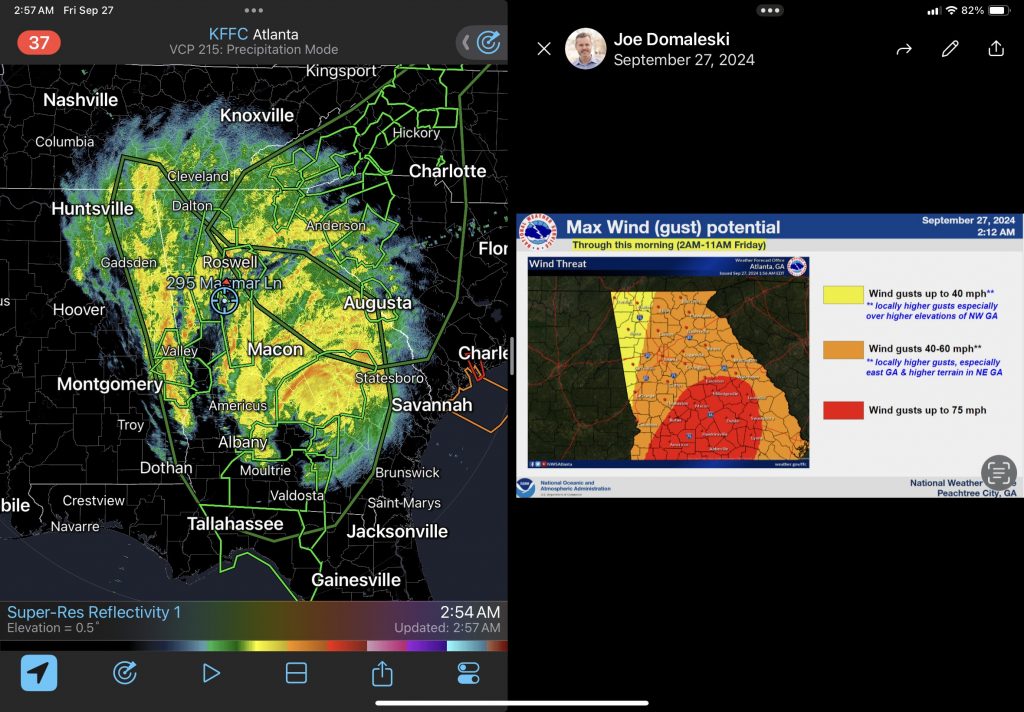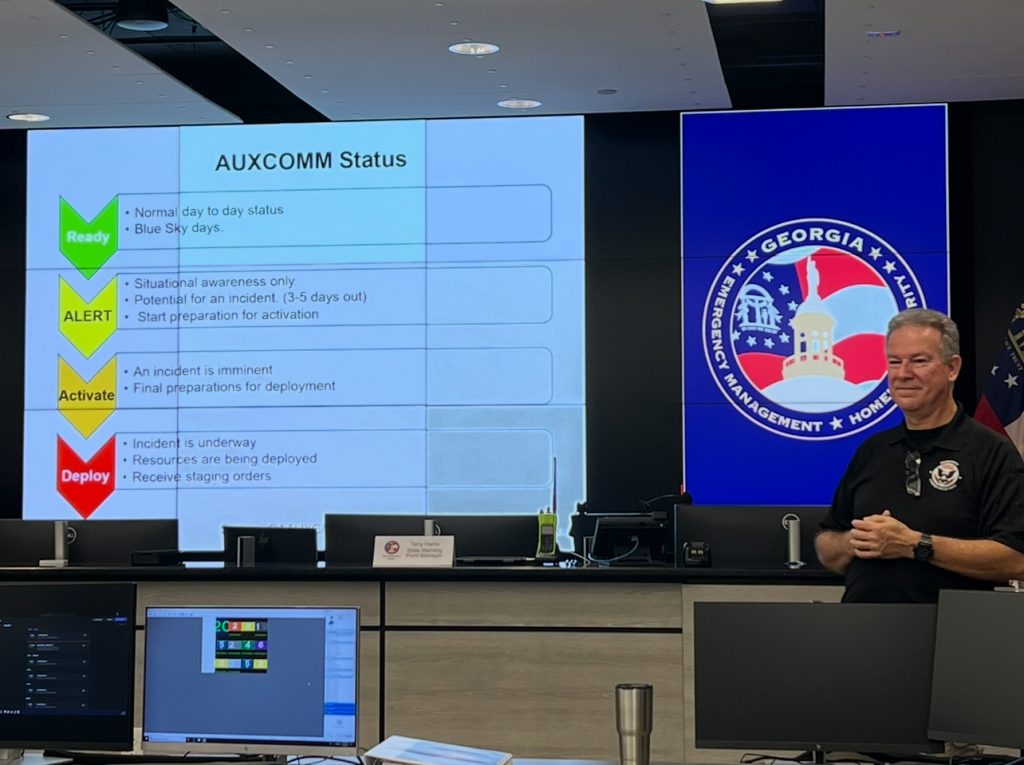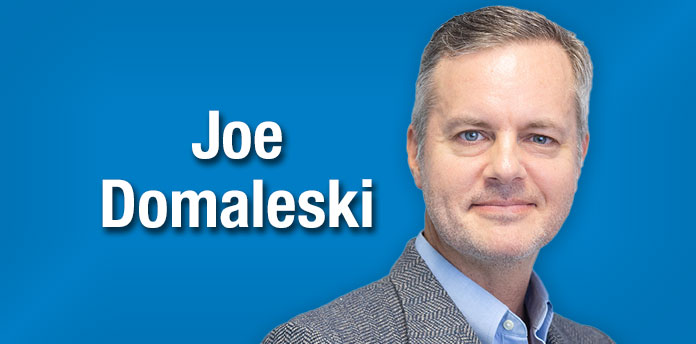We were spared, but many of our friends were not. You know what I’m talking about—Hurricane Helene. Last week, Helene ravaged Florida, Georgia, Tennessee, North Carolina, and South Carolina. It’s hard to see the images and videos of the devastation. Many areas will never be the same. There’s a good chance many of you have friends in the affected areas. As I write this article, recovery efforts are underway.
Before the storm came ashore on Thursday, September 26, we double-checked our preparations here at home in Fayette County. Based on the stock levels at local stores, it looks like many of you made preparations ahead of time, and that’s good. Two months ago, I shared my thoughts about emergency preparations, and it’s worth a read (or re-read). It’s important to have the essentials covered ahead of time.
During the night of 9/26 and the early morning hours of 9/27, I was running a radio net for Georgia Emergency Management and Homeland Security Agency (GEMA/HS) as a volunteer with the Georgia AuxComm program. Part of my job was to take field reports that came in over the radio. As I worked my radio, I also monitored two systems designed for emergency response personnel—WebEOC, which is used for coordination between emergency management agencies in Georgia, and NWSChat, which is used by the National Weather Service to communicate with various partner organizations. Both systems are restricted “back channel” methods of communication and coordination. I experienced two emotions as I watched the reports come in.

First, there was a sense of relief. Around 3 a.m., I noticed on the NWS system that the storm was tracking more toward the east than originally forecasted. Although it was raining heavily here in Fayette County, it became obvious that our immediate area would be largely spared. Unfortunately, that sense of relief was offset by a sense of growing dread. Around the same time, over on the GEMA/HS system, field reports were coming in that were shocking—entire counties were going dark—no power, internet, or cell service. Many 911 systems went down, and a few radio towers collapsed. I’m not allowed to divulge specifics, but many of the situations have now been reported by the news media. It’s simply shocking that in 2024, a city as large as Augusta and a county like Richmond, adjacent to the state-of-the-art Fort Eisenhower, could go dark with very few routes to get in or out of the area.
Things are so bad, that some of my ham radio friends from AuxComm were airlifted into affected areas over the weekend. They were flown in Georgia State Patrol helicopters for speed and safety, since many roads are still blocked. Their mission is to help restore communications around the state. Just before I started typing up this article, I was on a conference call with our team and they’ve completed one round of restorations and are flying to new areas tonight . You can watch a video of it below. The ham radio volunteers are the ones not wearing flight suits. The boxes they’re handling contain communications equipment.
What would you do if our grid went down and you were unable to travel out of this area?
Although food, water, and shelter are of paramount importance, so is communication. How would you let loved ones know you’re okay? If you weren’t in the affected area but wanted to check on loved ones who were, how would you do that? In this article, I’m going to share some specific ways you could communicate when the grid goes down. By “grid,” I mean phone lines, cellular service, internet, and power. When one or more of those fail, that’s a “grid down” situation.
You already know I’m a fan of amateur (ham) radio communications. Simply stated, it just works when everything else fails. It’s still a viable means of communication and is very resilient to infrastructure outages. Earlier this year, I wrote an article about it entitled – “If the grid goes down, amateur (ham) radio works when all else fails“. Ironically, on Saturday, I was teaching a pre-planned “ham cram” class for Fayette County Parks & Rec to help people get licensed. The timing of the class and its relevance couldn’t be better. We’ll explore some ways ham radio can be used, but we’ll also consider other methods. Here’s a short video of our class.
Ham Radio: The Ultimate Backup
As I mentioned earlier, I’m a big advocate for amateur (ham) radio, and it’s not just because I enjoy the hobby. During Hurricane Helene, ham radio operators played a critical role in coordinating communications services and relaying vital information when all other systems failed. Ham radio doesn’t rely on the grid—no internet, cell towers, or phone lines required. With basic equipment and a license, you can communicate over long distances when everything else is down. For those of you who want to ensure you’re never completely cut off, learning ham radio and getting licensed is one of the best investments you can make. I always have a radio with me and have personally used it when I was out of cell phone range during a car breakdown in the mountains. If you want more information, leave me a comment below. Even if you aren’t a ham radio operator, you probably know one who might be able to help. It’s one reason I’m so vocal about it—I want people to know I’m here to help if I can.
FRS and GMRS: Short-Range Solutions
While ham radio is the go-to for both long-range and short-range communications, Family Radio Service (FRS) and General Mobile Radio Service (GMRS) radios are excellent for short-range, local communication. These radios don’t require any special skills, and FRS radios, in particular, are unlicensed and easy to use. GMRS radios have a longer range but do require a license. If you’re looking for an easy way to stay in touch with neighbors or within a small area during a crisis, having a set of these radios on hand is a smart move. You can buy them at many local stores. Be sure to buy extra batteries and test them out BEFORE you actually need to use them in an emergency situation.
Text and Email: Limited but Reliable
Even when the grid is down, there’s a chance that text messaging might still work. Texts require less bandwidth than voice calls, meaning they often get through, even with weak signals. If you find yourself in a disaster zone with poor service, try sending a text first. It may be delayed, but it could still go through eventually.
Similarly, email can work if you find a way to access the internet. If you have a data connection on a cell network, that’s ideal, but oftentimes, that’s one of the first things to fail. You might be able to locate a public Wi-Fi location that’s still active. We’ll talk about that below. Another way to send/receive email is Winlink, which uses ham radio as a type of modem (remember those?) for email delivery over radio. APRS is another amateur radio technology that can be used to send “text messages” over the airwaves.
Finding Wi-Fi Hotspots: Your Connection to the Outside World
When cell service is down, finding a public Wi-Fi hotspot could be your lifeline. Libraries, coffee shops, hospitals, schools, and public buildings with backup generators often have Wi-Fi available, even when the power grid is down. Knowing where to find these hotspots can make all the difference when trying to send an email or use social media for updates. If you prepare ahead of time by identifying Wi-Fi hotspots in your area and downloading offline maps, you’ll have a better chance of staying connected during a prolonged outage. I have a friend right now who’s in the Augusta area. She doesn’t have access to cell service or power but is within walking distance of a facility that has a generator going and active Wi-Fi. My guess is that the Wi-Fi is connected to a satellite Internet service that is working. She’s using it to send updates through social media, which is how I knew about her situation.
Social Media: Staying Informed and Connected
When you can find a working internet connection, social media can be a powerful tool for both receiving and distributing information. Platforms like Facebook, Twitter, and Nextdoor are frequently updated with real-time information from communities, relief organizations, and emergency services. During disasters, these platforms can help you locate shelters, communicate with authorities, or find out about ongoing relief efforts. Just remember that social media is only useful when you have internet access, so it’s best to have multiple backup plans for communication.
U.S. Mail: The Old-Fashioned Lifeline
Until recently, I would’ve recommended the U.S. Mail as a resilient, old-school way to get messages out of an affected area. With well-publicized failures of local post offices and the new Fairburn sorting facility, I’m a little reluctant to list this method. I’ll leave it in here for now, but know that I’ve also experienced bad delays and outright non-delivery of mail. If you’re unable to communicate electronically, sending a letter or postcard could still help you reach loved ones. While it’s slower than digital communications, the postal service was designed to be a resilient option when the grid is down. Hopefully, service will improve in the future. In the meantime, maybe carrier pigeon would be more reliable than the U.S. Mail.
Red Cross and Emergency Services: Reconnecting Families
During and after disasters, the American Red Cross and local emergency services often set up special communication networks to help displaced families stay in contact. Many shelters offer these services, which can help you let others know you’re safe or check on loved ones in affected areas. The Red Cross also has online systems, like its “Safe and Well” program, which helps reunite families during disasters. If you’re trying to locate loved ones in an affected area—or—get the word out that you’re okay, consider looking into it.
Satellite Internet: Restoring Connectivity from the Sky
In recent years, satellite internet services like Starlink have become game changers for restoring internet access in disaster-stricken areas. Unlike traditional internet, which relies on land-based infrastructure, satellite internet beams connectivity directly from satellites in low Earth orbit to user terminals on the ground. This allows for high-speed internet access in areas where power lines, cell towers, and fiber optic cables have been damaged or destroyed. During emergencies, satellite internet can help coordinate relief efforts, enable video calls, and support real-time updates. Starlink, in particular, is actively being deployed right now by GEMA/HS as part of the Hurricane Helene emergency response. For organizations and individuals looking to ensure uninterrupted internet access during a crisis, satellite internet is becoming an increasingly viable solution.
Satellite Phones: Reliable Communication from Anywhere
When landline and cellular systems fail, satellite phones provide a reliable way to stay connected, even in the most remote or disaster-stricken areas. Unlike cell phones, satellite phones communicate directly with orbiting satellites, bypassing damaged or non-functional terrestrial infrastructure like cell towers and power lines. While satellite phones can be expensive and require service subscriptions, they’re very reliable for emergency communication. Rescue teams, government agencies, and individuals in disaster zones often rely on satellite phones to relay critical information. If you’re preparing for a worst-case scenario, a satellite phone can ensure you’re never completely cut off from the outside world. As the technology has advanced, the pricing of satellite phones has actually made them affordable for private citizens like you and me.
Satellite Messaging Devices: Texting When There’s No Signal
For those who don’t need full satellite phone capabilities, satellite messaging devices like SPOT and Garmin inReach offer a simpler, more affordable solution. These devices allow you to send text messages through satellites, even when there’s no cell service or internet available. They are perfect for sending quick check-ins to loved ones or emergency messages to authorities. Some models, like the Garmin inReach, even allow for two-way communication and GPS tracking. Subscription plans are usually required, but the cost is far lower than satellite phones, making them a practical option for staying in touch during disasters or remote travel. Newer models of iPhones also have an emergency SOS via satellite feature.
Drones for Message Delivery: Reaching Remote or Cut-Off Areas
In recent years, drones have emerged as both a weapon and a tool for helping deliver vital supplies and messages to areas cut off by disasters. Equipped with cameras and small containers, drones can deliver physical messages, medical supplies, or even Wi-Fi routers to areas where traditional routes are blocked. For instance, after major hurricanes, drones have been used to assess damage and deliver aid to isolated communities. While drone usage in emergencies is still developing, they offer a promising way to bridge communication gaps when roads are impassable or infrastructure is severely damaged. As the technology advances, drones may become a standard tool in disaster response.
Field Expedient Methods: Low-Tech Solutions in Crisis
When high-tech communication methods are unavailable, sometimes the simplest solutions work best. Field expedient methods like community bulletin boards and public announcement systems can play a role in maintaining communication in a grid-down situation. After disasters, many communities set up physical message boards in public areas, allowing residents to post updates, request help, or leave messages for loved ones. Similarly, portable PA systems or bullhorns can be used to broadcast vital information when other communication channels are unavailable. While these low-tech methods lack the speed and range of digital tools, they are often among the most effective ways to get critical information to people in affected areas. I’ve even seen examples where people hold up signs saying they’re okay while a news crew films them in an affected area.

Ensuring You’re Never Out of Touch
In times of disaster, staying connected can be a matter of survival. From ham radio and satellite phones to drones and Wi-Fi hotspots, there are numerous ways to maintain communication when the grid goes down. Each method has its strengths—ham radio for “when all else fails” versatile radio communication, FRS and GMRS for local point-to-point communications, satellite messaging for remote updates, and even low-tech options like field bulletin boards and signs. The key is to have a mix of tools ready, ensuring you can stay in touch with loved ones or emergency services when traditional infrastructure fails.
The devastation left by Hurricane Helene is tragic. It’s a reminder that we can’t take modern conveniences like cell phones and the internet for granted. Now is the time to get prepared! There’s lots of ways to do that by getting a ham radio license (or locating hams in your area), getting familiar with alternate communications methods, or purchasing a satellite phone or internet system. And don’t overlook old-school, low-tech methods of communication like bulletin boards or handwritten messages—they can still be vital in a crisis. Over the past few days we’ve seen how quickly communications can fail and stay offline for an extended period of time. Don’t wait for the next storm to realize how essential these systems are. Take the steps now to ensure you’re ready for whatever comes next.
[Joe Domaleski, a Fayette County resident for 25+ years, is the owner of Country Fried Creative – an award-winning digital marketing agency located in Peachtree City. His company was the Fayette Chamber’s 2021 Small Business of the Year. Joe is a husband, father of three grown children, and proud Army veteran. He has an MBA from Georgia State University and enjoys sharing his perspectives drawing from thirty years of business leadership experience. Joe is a recipient of the Peachtree City Rotary Club Business Leader of the Year Award for 2024. Sign up for the Country Fried Creative newsletter to get marketing and business articles directly in your inbox. You can connect with Joe directly on LinkedIn or follow his new blog Marketing Data Science for more insights and updates.]









Leave a Comment
You must be logged in to post a comment.